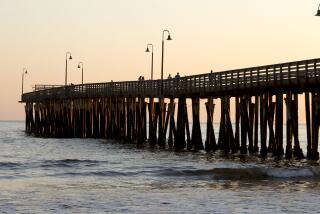4 Developments Open Today at Coto de Caza
Today’s grand opening of housing developments by three major Southland builders marks the transition of Coto de Caza from a slow-growth rural hideaway to a major first- and second-home resort community.
“We plan to keep the integrity of the original private resort community with low-density development while reorienting Coto de Caza as a primary home community,” said Rod Gilliland, vice president of sales and marketing for Coto de Caza Development Co., a division of Arvida of Boca Raton, Fla. and Chevron Land & Development Co., Irvine.
From the current 250 houses, the gate-guarded 4,000-acre development in the Trabuco Valley between Rancho Santa Margarita and the Cleveland National Forest in southeastern Orange County is expected to grow to slightly more than than 6,000 dwelling units when it is built out in 10 to 15 years, Gilliland said.
“The new master plan (developed by Forma, a Newport Beach-based planning firm) calls for 1.2 homes per acre, but that doesn’t mean we’ll have houses evenly distributed on the property,” he added.
“Obviously, the density will be higher along the golf course and in the condominium developments and we will have lots ranging from about one-third acre to about seven acres for custom homes.”
The latter lots are expected to sell from about $125,000 to about $300,000, he said.
The 18-hole golf course--at 7,085 yards the longest in Orange County--opened Feb. 2. It was designed by Robert Trent Jones Jr. and joins the Coto de Caza equestrian center, a sports center, a trap and skeet facility, fishing ponds, a 100-room resort, conference center and the Vic Braden Tennis College as amenities in the development.
The equestrian center was the site of the Modern Pentathlon of the 1984 Summer Olympics.
The four developments opening today include Fairway Oaks, 78 condominiums by Gfeller Development; Country Homes, 77 three- and four-bedroom single-family houses by Pacesetter Homes, and East Point, 46 four-bedroom one- and two-story single-family houses and the Terraces, 120 two- to three-bedroom detached patio homes by J. M. Peters Co.
The Gfeller condominiums range in size from 1,355 to 1,509 square feet and are priced from about $150,000--the exact price range was not available at press time.
The Pacesetter Homes units have 1,938 to 2,357 square feet and are priced from $190,000 to $269,000. The single-family houses by Peters have 2,753 to 3,369 square feet and are priced from $305,000 to $420,000, while the patio homes are priced from $175,000 to $275,000 and have 1,464 to 2,300 square feet.
Coto de Caza President John Yelverton said that the master plan ensures that--despite the large number of dwelling units--large amounts of open space and the lack of ridge line building will preserve the “get-away-from-it-all” ambiance of Coto de Caza.
“We’ve already donated 500 acres for Wagon Wheel Regional Park and we’re committed to preserving 1,758 acres as green belts and open space between new home projects,” Yelverton said.
The completion of Santa Margarita Parkway has reduced the driving time from Coto de Caza to the John Wayne Orange County Airport to about 30 minutes, he added.
Yelverton said that research studies done for Coto de Caza reveal that 80% of the houses being built will be primary residences, with the other 20% sold to second-home buyers.
“The idea of someone in Los Angeles buying a resort home in an inland area of Orange County may seem rather strange, but since Coto de Caza is considerably more accessible than Palm Springs to a lot of Los Angeles residents, it really is a more usable vacation spot--especially for quick getaways,” according to Gilliland.
“With its rolling hills, grassy meadows and abundance of ancient trees and wild shrubs, Coto is a unique place for unwinding that few people are aware of at the moment.”
Gilliland admitted that some of the longtime residents of Coto--there are about 600 people living there--are apprehensive about the stepped-up development pace. He added that virtually everyone who bought in the isolated community realized that one day the original developers would sell to a more growth-oriented firm.
An eight-year Coto resident, who requested anonymity, said that a lawsuit by homeowners forced the developers to change plans to relocate the hunt club. He said that children living in Coto de Caza attend schools in Mission Viejo because the master plan has no provision for schools. Too, access to the development is limited to the one road, Santa Margarita Parkway, which has heavy truck traffic in the wake of the rapid development of Rancho Santa Margarita.
“I loved Coto de Caza when we moved in eight years ago and I still love it,” he said. “This place is big enough that it can stand development without being destroyed.”
More to Read
Sign up for Essential California
The most important California stories and recommendations in your inbox every morning.
You may occasionally receive promotional content from the Los Angeles Times.






